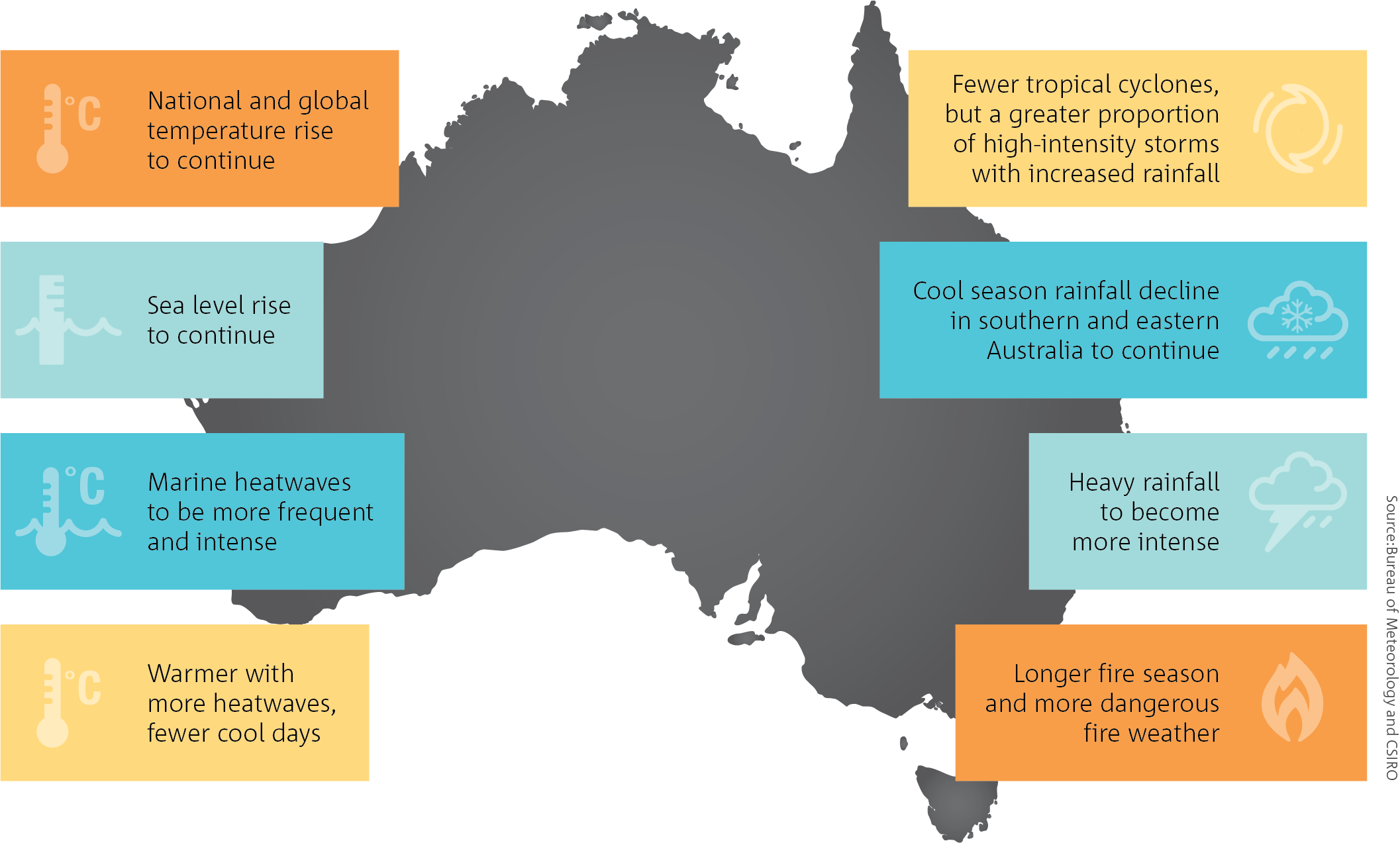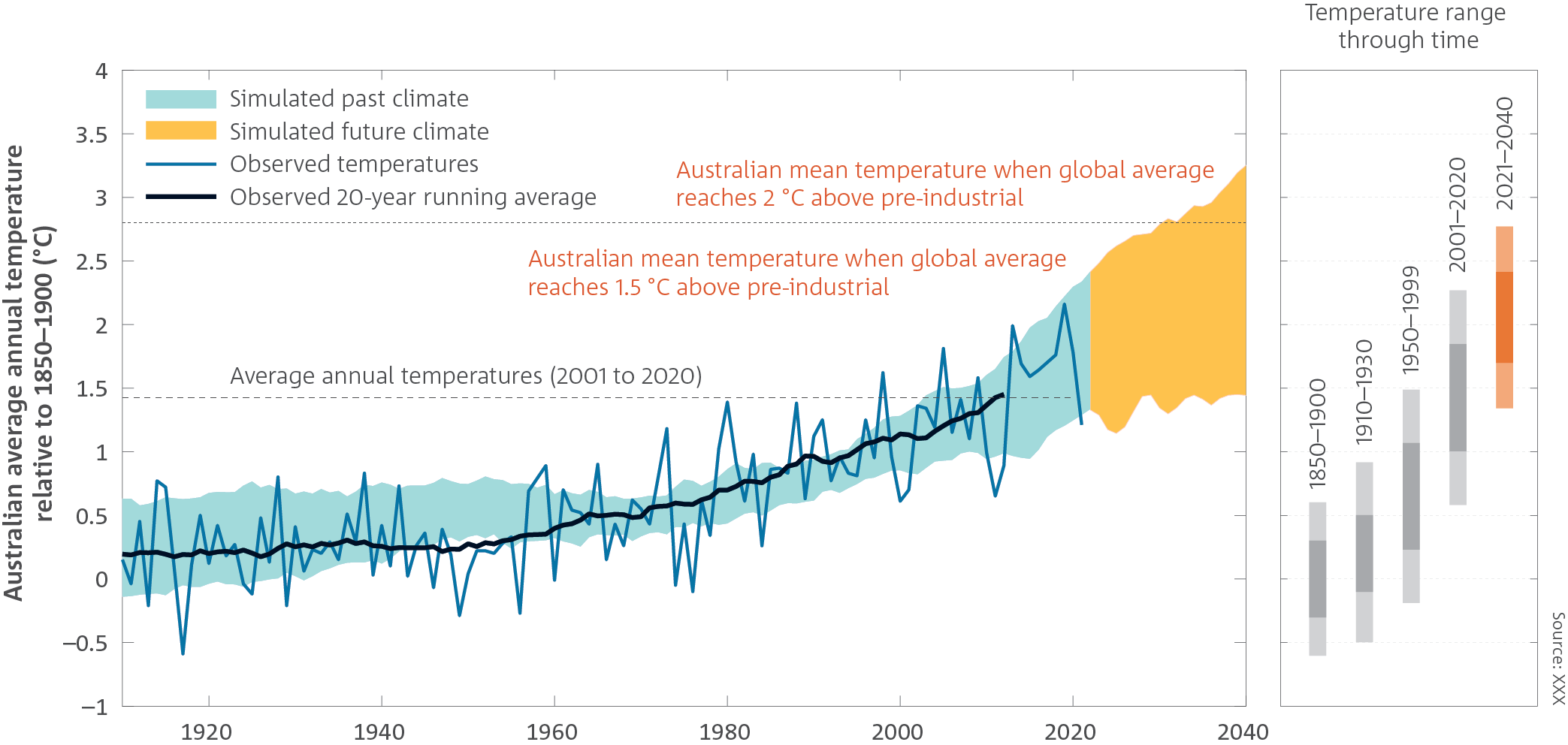New research in Australia and around the world, together with the IPCC’s Sixth Assessment Report, enhance understanding of the state of Australia's future climate. In coming decades, Australia is projected to experience:
- Continued warming, with more extremely hot days and fewer extremely cool days.
- A further decrease in cool season rainfall across many regions of the south and east.
- Continued drying in the south-west of Western Australia, especially during winter and spring.
- Longer periods of drought on average in the south and east.
- A longer fire season for the south and east, and an increase in the number of dangerous fire weather days.
- More intense short-duration heavy rainfall events, even in regions where the average rainfall decreases or stays the same. This will lead to a complex
mix of effects on streamflow, and associated flood and erosion risks, including increased risk of small-scale flash flooding. - Fewer tropical cyclones, but a greater proportion projected to be of high intensity, with ongoing large variations from year to year.
- The intensity of rainfall associated with tropical cyclones is also expected to increase and, combined with higher sea levels, is likely to amplify the impacts from those tropical cyclones that do occur.
- Fewer east coast lows on average, particularly during the cooler months of the year.
- Ongoing sea level rise through this century and beyond, at a rate that varies by region. Recent research on potential ice loss from the Antarctic ice sheet suggests that a scenario of larger and more rapid sea level rise can’t be ruled out.
- More frequent extreme sea levels linked to coastal inundation and coastal erosion. For most of the Australian coast, extreme sea levels that had a probability of occurring once in a hundred years are projected to become an annual event by the end of this century with lower emissions, and by the mid-21st century for higher emissions.
- Continued warming and acidification of surrounding oceans with consequent impacts on biodiversity and ecosystem processes.
- Increased and longer-lasting marine heatwaves, which will further stress marine environments, such as kelp forests, and increase the likelihood of
more frequent and severe bleaching events in coral reefs around Australia, including the Great Barrier Reef and Ningaloo Reef. - An increase in the risk of natural disasters from extreme weather, including ‘compound extremes’, where multiple extreme events occur together or in sequence, thus compounding their impacts.

Projections of Australia’s average temperature over the next two decades show:
- The average temperature of each future year is now expected to be warmer than any year prior to the commencement of human-caused climate change. This is scientifically referred to as climate change 'emergence'.
- Ongoing climate variability means each year will not necessarily be hotter than the last, but the underlying probabilities are changing. This leads to less chance of cool years and a greater chance of repeatedly breaking Australia’s record annual average temperature (e.g. record set in 2005 was subsequently broken in 2013 and then again in 2019).
- While the previous decade was warmer than any other decade in the 20th century, it is likely to be the coolest decade for the 21st century.
- The average temperature of the next 20 years is virtually certain to be warmer than the average of the past 20 years.
- The amount of climate change expected in the next decade is similar under all plausible global emissions scenarios. However, by the mid-21st century, higher ongoing emissions of greenhouse gases will lead to greater warming and associated impacts, while lower emissions will lead to less warming and fewer impacts.
- Warming is generally expected to be greater in the interior of Australia than near the coast.

Why are Australia and the world warming?
Energy comes from the Sun. In order to maintain stable temperatures at the Earth’s surface, in the long run this incoming energy must be balanced by an equal amount of heat radiated back to space. Greenhouse gases in the atmosphere, such as CO2, act to increase the temperature of the Earth's surface, ocean and atmosphere, by making it harder for the Earth to radiate this heat. This is called the greenhouse effect.
Without any greenhouse gases, the Earth's surface would be much colder, with an average temperature of about –18 °C, due to the radiation balance alone (even colder when feedback mechanisms are considered). For centuries prior to industrialisation, the incoming sunlight and outgoing heat were balanced, and global average temperatures were relatively steady, at a little under 15 °C. Now, mostly because of the burning of fossil fuels and changes in land use, the concentrations of greenhouse gases in the atmosphere are rising and causing surface temperatures to increase.
This increase in greenhouse gases, along with an increase in aerosol particles in the air and the flow-on effects to clouds, has created an 'effective radiative forcing' of 2.72 W m-2 (averaged globally). The atmosphere and oceans will continue to warm until enough extra heat can escape to space to allow the Earth to return to balance. Because CO2 persists in the atmosphere for hundreds of years, further warming and sea level rise are locked in. This well-established theory, together with observations of the air, water, land and ice, as well as paleoclimate records and climate models, allows us to understand climate changes and make projections of the future climate.
New research in Australia and around the world, together with the IPCC’s Sixth Assessment Report, enhance understanding of the state of Australia's future climate. In coming decades, Australia is projected to experience:
- Continued warming, with more extremely hot days and fewer extremely cool days.
- A further decrease in cool season rainfall across many regions of the south and east.
- Continued drying in the south-west of Western Australia, especially during winter and spring.
- Longer periods of drought on average in the south and east.
- A longer fire season for the south and east, and an increase in the number of dangerous fire weather days.
- More intense short-duration heavy rainfall events, even in regions where the average rainfall decreases or stays the same. This will lead to a complex
mix of effects on streamflow, and associated flood and erosion risks, including increased risk of small-scale flash flooding. - Fewer tropical cyclones, but a greater proportion projected to be of high intensity, with ongoing large variations from year to year.
- The intensity of rainfall associated with tropical cyclones is also expected to increase and, combined with higher sea levels, is likely to amplify the impacts from those tropical cyclones that do occur.
- Fewer east coast lows on average, particularly during the cooler months of the year.
- Ongoing sea level rise through this century and beyond, at a rate that varies by region. Recent research on potential ice loss from the Antarctic ice sheet suggests that a scenario of larger and more rapid sea level rise can’t be ruled out.
- More frequent extreme sea levels linked to coastal inundation and coastal erosion. For most of the Australian coast, extreme sea levels that had a probability of occurring once in a hundred years are projected to become an annual event by the end of this century with lower emissions, and by the mid-21st century for higher emissions.
- Continued warming and acidification of surrounding oceans with consequent impacts on biodiversity and ecosystem processes.
- Increased and longer-lasting marine heatwaves, which will further stress marine environments, such as kelp forests, and increase the likelihood of
more frequent and severe bleaching events in coral reefs around Australia, including the Great Barrier Reef and Ningaloo Reef. - An increase in the risk of natural disasters from extreme weather, including ‘compound extremes’, where multiple extreme events occur together or in sequence, thus compounding their impacts.
Warmer with more heatwaves, fewer cool days, Fewer tropical cyclones, but a greater proportion of high-intensity storms with increased rainfall, Cool season rainfall decline in southern and eastern Australia to continue, Heavy rainfall to become more intense, Longer fire season and more dangerous fire weather.
For a full description of this figure please contact: www.csiro.au/contact
Projections of Australia’s average temperature over the next two decades show:
- The average temperature of each future year is now expected to be warmer than any year prior to the commencement of human-caused climate change. This is scientifically referred to as climate change 'emergence'.
- Ongoing climate variability means each year will not necessarily be hotter than the last, but the underlying probabilities are changing. This leads to less chance of cool years and a greater chance of repeatedly breaking Australia’s record annual average temperature (e.g. record set in 2005 was subsequently broken in 2013 and then again in 2019).
- While the previous decade was warmer than any other decade in the 20th century, it is likely to be the coolest decade for the 21st century.
- The average temperature of the next 20 years is virtually certain to be warmer than the average of the past 20 years.
- The amount of climate change expected in the next decade is similar under all plausible global emissions scenarios. However, by the mid-21st century, higher ongoing emissions of greenhouse gases will lead to greater warming and associated impacts, while lower emissions will lead to less warming and fewer impacts.
- Warming is generally expected to be greater in the interior of Australia than near the coast.
Why are Australia and the world warming?
Energy comes from the Sun. In order to maintain stable temperatures at the Earth’s surface, in the long run this incoming energy must be balanced by an equal amount of heat radiated back to space. Greenhouse gases in the atmosphere, such as CO2, act to increase the temperature of the Earth's surface, ocean and atmosphere, by making it harder for the Earth to radiate this heat. This is called the greenhouse effect.
Without any greenhouse gases, the Earth's surface would be much colder, with an average temperature of about –18 °C, due to the radiation balance alone (even colder when feedback mechanisms are considered). For centuries prior to industrialisation, the incoming sunlight and outgoing heat were balanced, and global average temperatures were relatively steady, at a little under 15 °C. Now, mostly because of the burning of fossil fuels and changes in land use, the concentrations of greenhouse gases in the atmosphere are rising and causing surface temperatures to increase.
This increase in greenhouse gases, along with an increase in aerosol particles in the air and the flow-on effects to clouds, has created an 'effective radiative forcing' of 2.72 W m-2 (averaged globally). The atmosphere and oceans will continue to warm until enough extra heat can escape to space to allow the Earth to return to balance. Because CO2 persists in the atmosphere for hundreds of years, further warming and sea level rise are locked in. This well-established theory, together with observations of the air, water, land and ice, as well as paleoclimate records and climate models, allows us to understand climate changes and make projections of the future climate.
